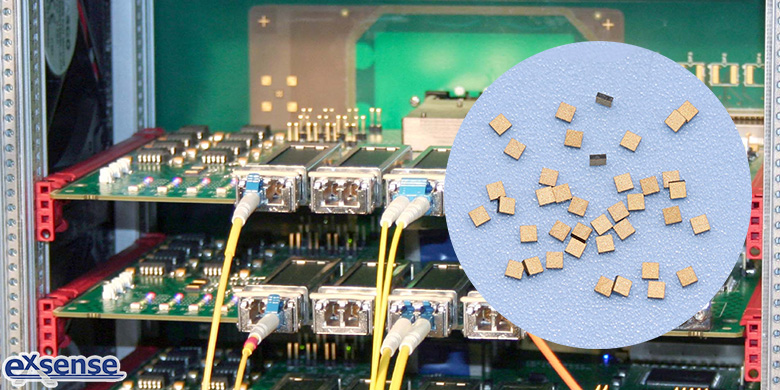
Optical transceiver is the core device of optical communication industry, which consists of receiving and transmitting two parts. Among them, the receiving part realizes optical-electric transformation, and the transmitting part realizes electric-optical transformation. NTC thermistor chip for optical transceiver produced by EXSENSE Electronics Technology Co., Ltd. plays the role of temperature protection and temperature monitoring in the optical transceiver, effectively ensuring the normal operation of the optical transceiver. What criteria should be considered when selecting an optical transceiver? Next, let EXSENSE Electronics answer one by one for you:
First, the output optical power is the output power of transmitting end optical source of the optical transceiver, which can be understood as the intensity of light in units of W or mW or dBm. Where W or mW are linear units and dBm are logarithmic units. In communication, we usually use dBm to express optical power.
Formula: P (dBm) = 10Log (P/1mW)
For passive optical network (PON) products, due to its optical network unit (ONU) uses burst mode, so it needs to use a special optical power meter for measurement, which is connected in series. Gives the current upstream and downstream optical power in real time.
Second, receiving sensitivity refers to the minimum received optical power of the optical transceiver at a certain rate and bit error rate, the unit is dBm. Generally, the higher the rate is, the worse the receiving sensitivity is. That is, the larger the minimum received optical power is, the higher the requirements on the receiving components of the optical transceiver are.
Considering the increase of link loss caused by aging of optical fibers or other unforeseeable factors, the optimal range of the received optical power is 2~3dB above the receiving sensitivity and 2~3dB below the overload point.
Third, compression sensitivity refers to the sensitivity value of the input signal measured after jitter and vertical eye closure deterioration conditions are added, the unit is dBm. This concept is only for 10G interface modules (XENPAK modules and XFP modules).
Fourth, transmitted optical power and receiving sensitivity of the optical transceiver
Transmitted optical power refers to the luminous intensity of transmitting end, the receiving sensitivity refers to the luminous intensity that can be detected. Both of them are in dBm and are important parameters affecting transmission distance. The transmission distance of an optical transceiver is limited by loss and dispersion. The loss limit can be estimated by the following formula:
Loss-limited distance=(transmitted optical power-receiving sensitivity)/attenuation of optical fiber
Optical fiber attenuation depends on the actual selection of optical fiber. In general, the current G.652 optical fiber can achieve 0.5dB/km at 1310nm wave band and 0.3dB/km or better at 1550nm wave band. 50um multi-mode optical fiber can achieve 4dB/km at 850nm wave band and 2dB/km at 1310nm wave band. For hundred MBIT/s and thousand MBIT/s optical transceivers, the dispersion limitation is much more limited than the loss limitation, which may not be considered.
Fifth, saturated optical power value refers to the maximum optical power that can be detected by the receiving end of an optical transceiver. When the received optical power is greater than the saturated optical power, error codes will also be generated. Therefore, if the optical transceiver with high transmitting optical power is not added to the attenuation loopback test, error codes will occur.
Sixth, Light saturation, also known as saturation light power. It refers to the maximum input optical power (dBm) when maintaining a certain bit error rate (10-10~10-12) at a certain transmission rate.



